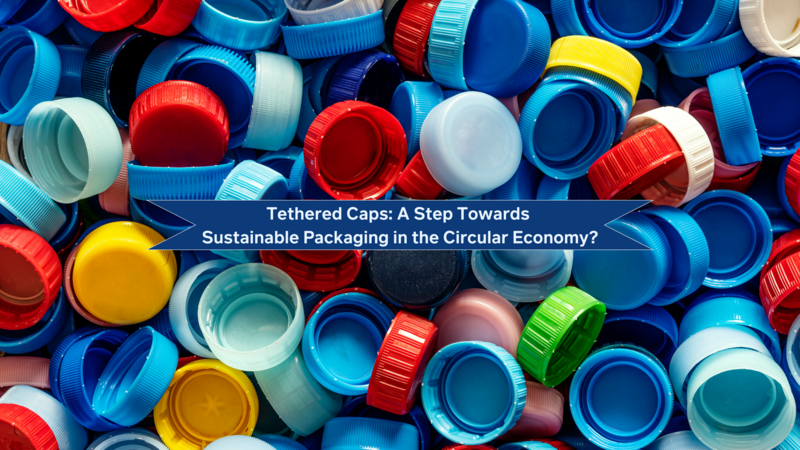Tethered Caps: A Step Towards Sustainable Packaging in the Circular Economy?
In the evolving plastic use and sustainability landscape, the conversation often turns towards innovative solutions that align with circular economy principles. One such innovation gaining momentum in the European Union is the implementation of tethered caps on plastic bottles.
Tethered caps, which remain attached to the bottle after opening, have become a focal point in packaging sustainability. This design counters the issue of small parts, like caps, needing to be recovered more frequently than the bottles themselves. Given their size, caps are more prone to becoming litter or misplaced, a significant concern in waste management.
In the realm of waste management, the benefits of tethered caps are multifold. During the sorting process of lightweight packaging, small caps often end up in fine fractions and are directed toward incineration rather than recycling. However, when these caps remain attached to their bottles, they can be effectively separated after the bottle shredding, enhancing the recycling potential. This process not only aids in waste management but also aligns with the goals of the circular economy by promoting the reuse of materials. Implementing tethered caps also aligns with the EU's Single-Use Plastics Directive. This directive, while primarily targeting the reduction of plastic waste, also encourages innovations that facilitate recycling and litter reduction. Although the directive's current method of counting items rather than their mass has faced criticism, the move towards tethered caps is a step forward in addressing these concerns.
The shift to tethered caps must be viewed critically, especially in the context of mixed plastic degradation. While they offer a solution to prevent littering and improve recycling rates, the challenge remains in effectively processing these mixed materials. Innovations in degradation techniques and recycling processes – aligning with MIX-UP's goals – are crucial to ensure these caps do not contaminate the recycling stream.
Critics argue that while tethered caps may reduce the likelihood of caps being littered, they do little to address the more significant issue of plastic pollution. Even with tethered caps, bottles are still predominantly made of plastic, contributing to environmental pollution, mainly if not properly recycled.
There's also a concern that such initiatives give consumers a false sense of contributing to ecological sustainability. Focusing on minor aspects like caps may overshadow the more significant and pressing issues of plastic production and waste. This can lead to a complacency where more significant, impactful actions should be taken.
Some see the promotion of tethered caps as corporations attempting to shift the responsibility of environmental stewardship onto consumers. By focusing on the proper disposal of lids, there's a risk of diverting attention from the corporations' need for systemic changes in production and packaging practices.
Still, the transition to tethered caps represents a move towards a circular economy, where the life cycle of materials is extended and waste is minimized. This approach is vital in plastics, which are often criticized for their environmental impact. By redesigning packaging elements to be more sustainable, we are taking essential steps towards a more responsible use of plastics.
Adopting tethered caps in the EU is a noteworthy example of how small design changes can have significant environmental impacts. Tethered caps serve as a model for sustainable packaging in line with circular economy principles by addressing the litter issue and enhancing the recyclability of plastics.
As we seek solutions in sustainable packaging, we must remember that every small step, like adopting tethered caps, can lead to substantial positive changes. This approach benefits the environment and sets a precedent for future packaging innovations. As we look towards the future, sustainable packaging will involve more than design changes like tethered caps. It will require a comprehensive approach, integrating advancements in material science, consumer behavior modifications, and policy reforms. The ongoing evolution in biodegradable plastics, improved recycling technologies, and increased public awareness are critical components in this journey.
Consumers play a pivotal role in this transformation. Awareness and education about the importance of sustainable packaging, proper disposal methods, and the broader impact of our consumption choices are vital. As consumers become more informed and demand more sustainable options, companies will be incentivized to invest in eco-friendly packaging solutions.
Despite the progress made, challenges remain. Balancing cost, functionality, and sustainability is a complex task. However, these challenges also present opportunities for innovation and creativity in designing packaging solutions that are both environmentally friendly and economically viable.
The transition to tethered caps is more than just a regulatory compliance measure; it symbolizes the slowly growing awareness and commitment to sustainability in the packaging industry. It embodies the spirit of the circular economy, emphasizing that every component, no matter how small, matters in our quest for a sustainable future.
As we embrace these changes and look forward to innovations, it's clear that sustainable packaging is not just a trend but a fundamental shift in how we view and interact with our environment. The journey is ongoing, and each step, like the introduction of tethered caps, brings us closer to a more sustainable and responsible world.


